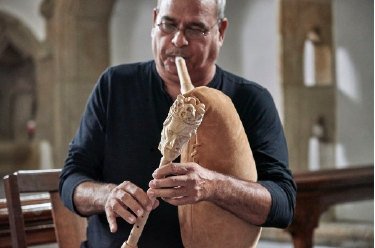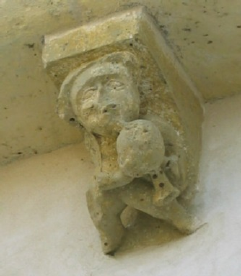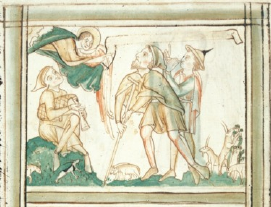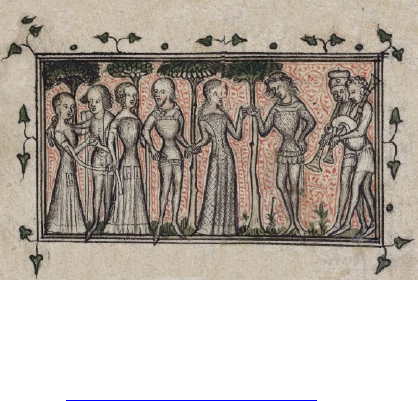The Bagpipe Society
Bagpipes and all things Medieval
Bagpipes and all things Medieval - Gill Page

Medieval Music in the Dales is the UK’s only festival of medieval music and we are really grateful for the continued support of The Bagpipe Society, our most consistent and valued sponsor. Every year we have featured Beginner Bagpipe sessions, usually run by Paul Leigh of Trouvere, and it’s a known fact that several shiny new bagpipers have been brought forth as a result… Most years, we’ve also had workshops for more experienced pipers, customarily run by Durham’s own Paul Martin. Both Pauls will be busy again at the 2020 festival (11‑13th September).
Bagpipes have also featured a lot in performance at the festival. In 2018, when our theme was medieval music from the British Isles, Paul Martin presented a wonderful set of tunes from English sources on his (as ever) impressive range of pipes, under the title ‘The English Medieval Bagpiper’. Other bagpipers at MMitD have included Paul Leigh in Trouvere, Katy Marchant, usually playing alongside Steve Tyler, the amazing women of Blondel (Emily Baines, Lizzie Gutteridge and Belinda Paul), Raúl Lacilla, Eduard Navarro, Graham Wright of Tritor and many others. Unforgettably, we also had Barnaby Brown performing at the 2018 festival. Medieval Music in the Dales of course also includes an International Exhibition by Instrument Makers and pipemakers have included Danilo Turchetti (with his amazing medieval-stylemusa), Jim Parr, Jon Swayne, Terry Mann and Martin Tiltnieks.
All this reflects the fact that bagpipes were a hugely important instrument in the middle ages. Many of us will be familiar with the hundreds of magnificent manuscript illustrations or carvings in stone or wood that record the popularity of the instrument. And yet… as with so many instruments, the evidence for it comes later than we might think.

Eduard Navarro at MMitD 2017
I’ve tried – I’ve really tried! – but I can’t find a medieval image of a bagpipe earlier than the twelfth century. I’m a historian by training and I like evidence a lot; going by the evidence there were no bagpipes in England before the middle of the thirteenth century by the earliest, while on the continent this can be put back a century or so at best. So, when Paul Martin led out our procession for the 1219 death of William Marshal at last year’s festival – to the sound of the bagpipes – we were in all honesty pushing things a bit… but not impossibly so at least, I like to think.
There are some written references to putative bagpipes earlier than the twelfth century (leaving aside the well-known Roman mentions). Mention must I suppose be made of Riddle 31 in the Anglo-Saxon Exeter Book; this has been interpreted as describing a bagpipe but to be honest it’s far from clear and should, I think, be ignored. More interesting is a ninth century letter which describes something called a chorus that could be a bagpipe – bag, couple of pipes, blow into one, sound comes out the other – but the trouble is this reference is explicitly referring toantiquis temporibus, “in ancient times” and not to anything contemporary. Much more convincing in – at the earliest – the later years of the eleventh century is the description of themusa by John Cotton, as a contemporary instrument: blown into by breath, regulated by the hand, animated by a bellows. Cotton was likely working in southern Germany but may have been English by birth. At a similar date there are Arabic references to themizmar (reed pipe) with a bag, which might have been known in Mediterranean regions. Peeping into the twelfth century, one Jewish commentator in Europe refers to an instrument played by shepherds that looks like an inflated wineskin.
The only problem with all this is that these descriptions could apply to something more like a bladder pipe; images associated with thechoruscertainly look more bladder pipe than bagpipe. Similarly, the twelfth century stone image in the church at Tosse in the Landes has a roughly spherical bag like that of a bladder pipe, and it also lacks the customary ‘under the arm’ position of the bagpipe. Still, the use of a bag of some kind is at least clear and we can posit some kind of bagpipe – in the widest sense – back at least as early as the close of the eleventh century. For all that, the bagpipe as we now know it, with bag under the arm and most likely combining a chanter and at least one drone, does not seem to arise until well into the twelfth century. Judging by the iconography, it could easily be supposed to be a twelfth century innovation.

The XIIth C stone carving of a piper on the church at Tosse, in the Landes, France
This leads to another point. It’s often posited that the earliest bagpipes were without drones, or at least without the separate drone pipes that we are most used to, having instead a drone and chanter combined in a single stock. Certainly, such bagpipes are seen in the twelfth and thirteenth century, but separate drones appear to me to be at least as common – of the six twelfth century images of bagpipes that I have located, four have a separate drone over the shoulder.
In England, the court records of Edward I, II and III show – unsurprisingly given the source – that the bagpipe was well-established in the highest circles as early as the 1290s. The instrument goes by various names, which are usually of French origin, reflecting the language and the social prejudices of the court. The first bagpipe player in England known to us by name is Hamond Lestivour; the name means estive-player, withestivebeing a French name for a type of bagpipe. Edward II employed a bagpiper by name Janin le Cheveretter – again using a French term, this time referring to the goatskin bag. Under Edward III the court had the services of at least two named
cornemusers (yet another French word) – John Perrot and John de Morleynes - and one ‘bagpiper’, by name Barber. There are also numerous named ‘pipers’, who might be bagpipers.
Of particular note, however, is a nameless minstrel who encountered the king’s sister Eleanor in 1332. The royal accounts record:
cuidam menestrello vocato Baggepiper facienti menelstrasium suam coram Domina Eleanora per proprias manus xiis
The lady Eleanor personally gave twelve shillings to this minstrel who was called simply ‘Baggepiper’, for making his minstrelsy in her presence; this was while the king’s sister was journeying, so it all happened outside London. This otherwise nameless provincial minstrel must have been over the moon; at this date a craftsman like a painter or carpenter could expect to make only a few pence a day. The simple English descriptiveness of ‘bagpiper’ seems quite striking and suggests that, perhaps, the instrument had in England a currency outside as well as inside the court. As noted above, at least one early reference associates the bagpipe (or something like it) with shepherds, and this was an association that persisted throughout the middle ages. Thank goodness the nativity story included shepherds as it’s thanks to this we have the majority of the gorgeous medieval images of the instrument! I think it at least possible that the bagpipe has a longer history than the iconography might support, but that, if so, this was very much outside the mainstream.

One of the earliest English depictions of a bagpipe c 1245-1260: BL Royal 2 B Vi f.8v British Library Yates Thomson 21, from the Catalogue of Illuminated Manuscripts
So, if you are concerned with historically informed performance as far as instrumentation goes, the bagpipe should not really appear until the twelfth century at the earliest. Admittedly, that does actually include most of the music we have available… From the close of the thirteenth century it is a very popular instrument across the social scale as shown by both written references and plentiful iconography.
Finally I can’t resist mentioning that though the 1832 Edinburgh Encyclopedia (shockingly!) describes the bagpipe as ‘an extremely defective and imperfect instrument in all its forms’, John Cotton, in perhaps around 1100, described the bagpipe (musa) assuperexcellens omnia instrumenta– that is, ‘by far the best of all instruments’. That’s more like it! This year at Medieval Music in the Dales, we look forward to plenty of bagpipe music as our theme is medieval dancing – and what better instrument for a medieval bop? Chris Elmes of Gaita, Myal Piper, Lizzie Gutteridge and Paul Martin are all lined up to provide bagpipe sounds for the dancing, and there will no doubt be many other pipers performing more informally on our Castle Stages and in our inimitable Castle Tavern.
More information at www.medievalmusicinthedales.co.uk
From Chanter Summer 2020.
- Data Processing Notice (GDPR)
@BagpipeSociety on X (formally known as Twitter)
TheBagpipeSociety on Instagram
 BagpipeSociety on Facebook
BagpipeSociety on Facebook
Something wrong or missing from this page? Let us know!
